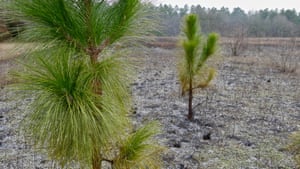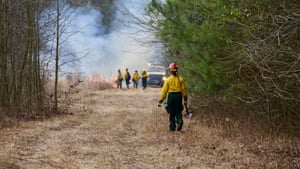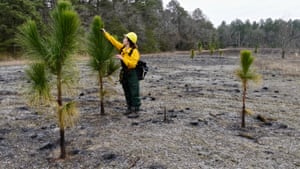Scientists use a strategy called assisted migration in an attempt to rescue tree species from inhospitable conditions
There
is an impressive array of pine species at the Nature Conservancy’s Plum
Creek preserve in Maryland – loblolly, Virginia, shortleaf – creating a
landscape that emits the smell of Christmas well into the summer. But a
newcomer to the preserve has fueled an ethical debate about the role of
conservationists in the age of climate change.
Since 2013, TNC has planted more than 2,000 longleaf pine seedlings in fields not far from the Delaware state line. Today, clumps of longleaf stand together like gangly kids at recess, their eponymous green needles shooting out like pompoms in every direction.
But longleaf is not native to Maryland, and many scientists believe they should not be planted at Plum Creek, or anywhere outside of their natural range. These relatively young trees are part of an experiment to determine if human intervention could help the pines migrate north as climate change alters its natural range.
When left unattended, trees migrate toward more favorable conditions through a process known as seed dispersal, in which seeds are carried by the wind or birds to new places, taking root where the weather and water are right. But it’s an exceedingly slow process, much slower than many trees will need to move in order to avoid major harm from warming temperatures. Scientists are turning to a strategy called assisted migration – planting seedlings in areas they have never grown – in an attempt to rescue tree species from the inhospitable conditions brought on by climate change.
Not everyone’s onboard. Assisted migration has been accused of being expensive and risky, a case of humans playing God.
But “I do not believe longleaf pine could move quickly enough at the
rate the climate is changing,” explains Dr Deborah Landau, a TNC
restoration ecologist.

Since 2013, TNC has planted more than 2,000 longleaf pine seedlings in fields not far from the Delaware state line. Today, clumps of longleaf stand together like gangly kids at recess, their eponymous green needles shooting out like pompoms in every direction.
But longleaf is not native to Maryland, and many scientists believe they should not be planted at Plum Creek, or anywhere outside of their natural range. These relatively young trees are part of an experiment to determine if human intervention could help the pines migrate north as climate change alters its natural range.
When left unattended, trees migrate toward more favorable conditions through a process known as seed dispersal, in which seeds are carried by the wind or birds to new places, taking root where the weather and water are right. But it’s an exceedingly slow process, much slower than many trees will need to move in order to avoid major harm from warming temperatures. Scientists are turning to a strategy called assisted migration – planting seedlings in areas they have never grown – in an attempt to rescue tree species from the inhospitable conditions brought on by climate change.
Not everyone’s onboard. Assisted migration has been accused of being expensive and risky, a case of humans playing God.

It’s this urgency that is fueling assisted migration projects like the one at Plum Creek Preserve, as well as six sites administered by the Adaptive Silviculture for Climate Change project. A collaborative effort between American and Canadian environmental agencies and universities, ASCC aims to help land managers understand how forests will respond to climate change and how they might play a part in facilitating it. In Minnesota’s Chippewa national forest, for example, where red oak and white spruce are becoming less suited to the climate, ASCC scientists are slowly introducing bitternut hickory and black cherry, species currently found in the climate zone directly south of the forest.
Dr Jim Guldin, one of ASCC’s lead researchers and a 30-year veteran of the USDA Forest Service, says that these trials are backed by “a lot of good science that shows that climatic conditions are going to change”, and when that happens “the species in a given place may no longer be a good fit for that spot”. He’s also quick to point out that the work is “very much an experiment”.
It’s the experimental nature of assisted migration that makes some scientists wary about the risks involved. In 2009, the ecologists Anthony Ricciardi and David Simberloff published an op-ed contending that the strategy was “likely to produce myriad unintended and unpredictable consequences” and could profoundly interrupt the established ecosystems and food webs where the new trees are planted. Assisted migration, they said, was tantamount to “ecological gambling”.
Assisted migration can also be a hard sell for the public, especially in communities that have been warned for years about the dangers of non-native plants and invasive species. Guldin reiterates that ASCC’s introductions are done in “very small steps”, and Landau argues that trees like longleaf pine require such specific management –namely, regular burns of the surrounding area that eliminate competing vegetation, enrich the soil, and kill harmful insects – and are so slow-growing that they’re “highly unlikely to escape” the plots where they are grown.
But this management isn’t cheap, and that’s another common criticism of assisted migration. Getting trees to grow outside of their normal habitat is labor-intensive work, and no amount of time or money can guarantee the trees will thrive in their new environment; half of the longleaf pine seedlings at the Plum Creek Preserve have died despite the best efforts of TNC staff.

Landau says that, on Facebook, TNC’s longleaf project has been accused of “playing the hand of God”. She dismisses the criticism. “There’s so little nature left that we haven’t already had a heavy hand in,” she says.
She’s more sympathetic to those who she says feel like assisted migration is giving up on existing restoration efforts. But so far, Maryland’s first stand of longleaf pine seems to be having a positive impact on the native flora and fauna of the area.
Months after the last burn, the preserve is teeming with raspberries and blueberries and displaying a diverse understory of native grasses. These grasses and shrubs are paradise for pollinators and ground-loving species like the bobwhite quail, a bird that has largely disappeared from the region in recent decades and is the focus of local restoration projects.
Maryland’s longleaf pine stand could provide “a starter forest of appropriate habitat” for the federally endangered red-cockaded woodpecker, which is beginning to face warming springs in its natural habitat, says Landau.
Despite the detractors, Landau has seen a shift in attitudes about assisted migration in the decade since Ricciardi and Simberloff’s article was published.
“Now that climate change is here, people are more open to the prospect of aiding species that won’t be able to keep up,” she says. “It’s happened. It’s happening. We need to respond.”
.png)

No comments:
Post a Comment